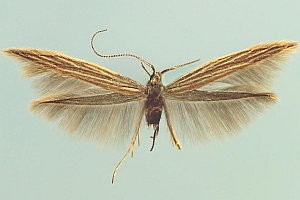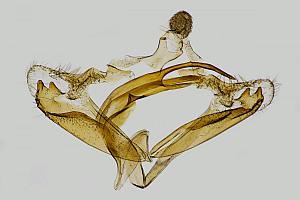

 +9Kontinente:EUAS
+9Kontinente:EUAS2. Diagnose
2.1. Männchen
2.2. Genitalien
2.2.1. Männchen
2.2.2. Weibchen
4. Weitere Informationen
Erwähnt sei die Schwierigkeit, die die Bestimmung dieses Tieres machte: František KOSORIN sandte ein e-mail an Giorgio BALDIZZONE, erhielt aber keine Antwort, ein weiteres an Ole KARSHOLT, der es an Jukka TABELL aus Finnland weiterleitete. Dieser schrieb dazu: „....the species is Coleophora subula (Falkovitsh, 1993). If I can remember right, I have determined it from Greece, althoug it is not mentioned from Europe according to the Baldizzone et al., (2006). I must check it. In Russia it is widespread, for example many specimens from South-Ural by Nupponen.....” Da ich die Verlässlichtkeit diese Bestimmung nicht einschätzen konnte, schickte ich das mail mit den Abbildungen zur Überprüfung an Andreas STÜBNER, der die Bestimmung bestätigte. (Text: Peter Buchner)
4.1. Andere Kombinationen
- Aureliania subula Falkovitsh, 1993 [Originalkombination]
- Ecebalia subula (Falkovitsh, 1993) [so bei Anikin et al. (2017)]
4.2. Synonyme
- Coleophora gongliuensis LI, 2004
4.3. Faunistik
Typus-Fundort ist die untere Wolga-Region. Verbreitung lt. Baldizzone et al., 2006: "Central Siberia, Altai, Tajikistan, Turkmenistan, Turkey, Russia (Lower Wolga); China (Xinjiang)".
Der vorliegende Falter aus der Slowakei ist der Erstnachweis der Art für Mitteleuropa. Es ist nicht auszuschließen, dass sie auch in Ostösterreich gefunden werden kann.
Szabőky, Tokár & Pastoralis (2007: 138) melden die Art erstmals aus Ungarn.
4.4. Typenmaterial
Фалькович (1993: 52): “Голотип: ♂, юго-западный Алтай, долина р. Катунь, 10 км западнее Катанды, 1200 м над ур. м., 6–8 VII 1983. Паратипы: 4 ♂, там же, 15–19 VII 1983; 1 ♂, там же, 20–21 VII 1983 (Миккола, хиппа и Ялава).”
4.5. Literatur
- Anikin, V.V., Sachkov, S.A. & V.V. Zolotuhin (2017): "Fauna lepidopterologica Volgo-Uralensis": from P. Pallas to present days. — Proceedings of the Museum Witt Munich, Volume 7: 1-696; Munich and Vilnius.
- Baldizzone, G. & H. W. van der Wolf (2000): Corrections of and additions to the Checklist of European Coleophoridae (Lepidoptera, Coleophoridae). — SHILAP Revista de lepidopterología 28 (112): 395-428.
- Будашкин, Ю. И. & А. В. Жаков (2013): Чехликовые моли (Lepidoptera, Coleophoridae): к фауне степной зоны Украины. Сообщение 3 [Budashkin, Yu. I. & A. V. Zhakov (2013): Case-Bearer Moths (Lepidoptera, Coleophoridae): Contribution to the Ukrainian Steppe Zone Fauna. Third Report]. — Українська ентомофауністика 4 (1): 33–42.
- Buschmann, F., Pastorális, G. & I. Richter (2014): Adatok a magyar faunában új Coleophora nigridorsella Amsel, 1935 és néhány más ritka Coleophora faj magyarországi elõfordulásához. The data for the new record of Coleophora nigridorsella Amsel, 1935 to the fauna of Hungary and to several other rare Coleophora-species occurring in the country (Lepidoptera: Coleophoridae). — Microlepidoptera.hu 7: 27–48. [PDF auf epa.oszk.hu]
- Erstbeschreibung: Фалькович, М. И. (1993): Новые виды чехлоносок (Lepidoptera, Coleophoridae) с Алтая. — Труды Зоологического института Российскии Академии Наук 251: 40-52.
- Szabőky, Cs., Tokár, Z. & G. Pastoralis (2007): New data to the Microlepidoptera fauna of Hungary, part X (Lepidoptera: Gracillariidae, Nepticulidae, Elachistidae, Coleophoridae, Gelechiidae, Tortricidae). — Folia entomologica hungarica 68: 137-142.













